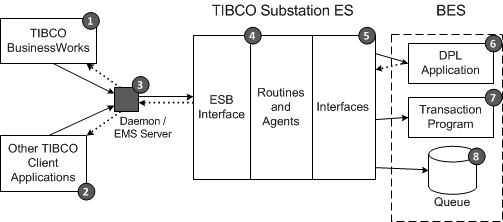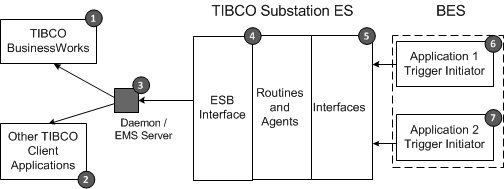Message Flow
CICS Interface supports two types of message flow: requests or replies, and triggers.
Requests or Replies
The following figure shows the message flow of the CICS interface for requests or replies:
- Either TIBCO BusinessWorks (1) or another TIBCO messaging client application (2) initiates a request that is passed to a messaging daemon or EMS server (3). The initiating request is denoted by solid arrows.
- The daemon or EMS server (3) forwards the request to Substation ES, where ESB Interface (4) receives and transforms the message data and then sends it to the appropriate interface (5).
- The interface (5) delivers the request to the application in the BES. In this example, the request is sent to a Distributed Link Request (DPL) application (6), Transaction Program (7), or Queue (8).
- Only the DPL application (6) returns a result set or acknowledgment, as denoted by the dotted arrows that return to the initiating applications.
Triggers
The following figure shows the message flow of the CICS interface for triggers:
- In a trigger, the request initiates within an application in the BES in the z/OS environment. In this figure, Applications 1 or 2 (6 or 7) initiate the request.
- The appropriate interface (5) in Substation ES receives the request and sends it to ESB Interface (4).
- ESB Interface (4) transforms the message to a Rendezvous or Enterprise Message Service message, which is carried by the daemon or EMS server (3). From there, it can be sent to TIBCO BusinessWorks (1) or other TIBCO messaging clients (2).
In triggers, no result set or acknowledgment goes back to the initiator (6 or 7), hence no dotted arrows back to the initiator in this figure.
Copyright © Cloud Software Group, Inc. All rights reserved.


